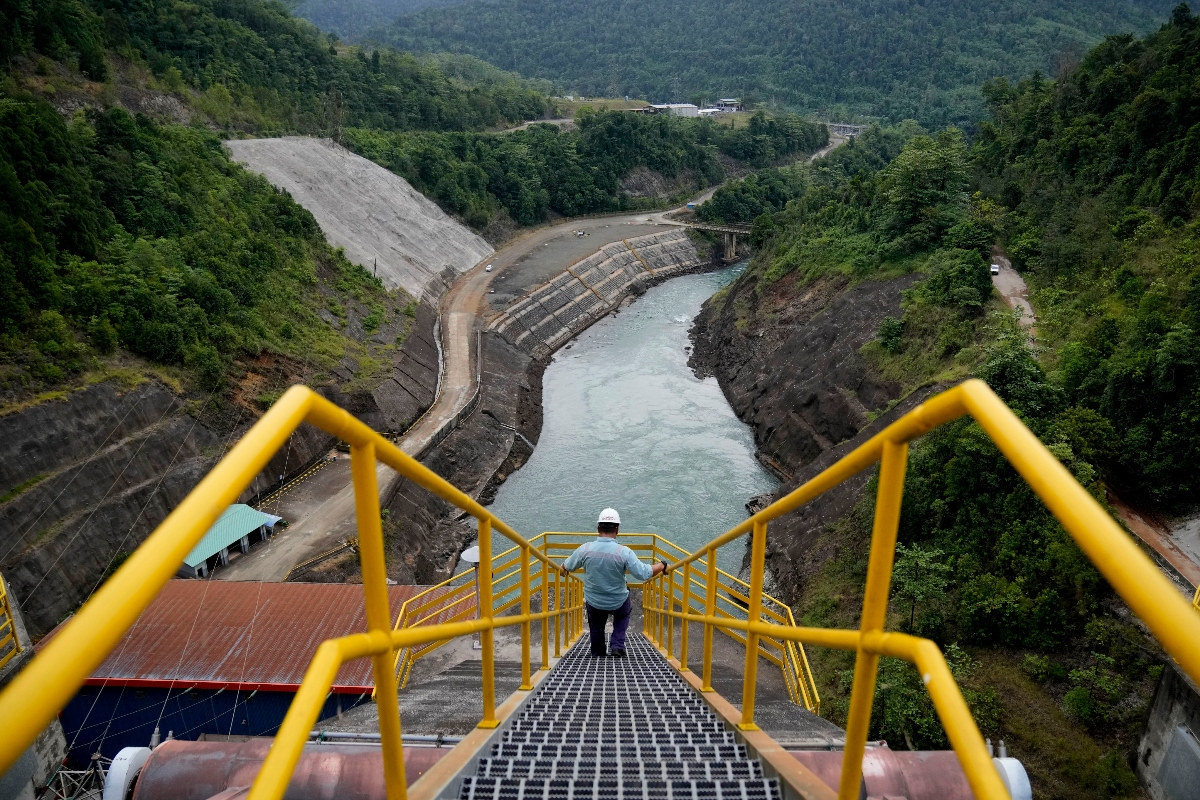Support strong Canadian climate journalism for 2025
The Kawasi people of Indonesia’s Obi Islands have long fished for tuna, red snapper and grouper, and grown coconut, cashew and clove trees. But some village residents say their land and water have been destroyed and the quality of life has plummeted in the years since Harita Nickel, the $5-billion arm of Indonesian conglomerate Harita Group, started mining, refining and processing nickel in their backyard.
“We lost our plantation land to grow crops for our survival and future generations. We lost the right to express our opinions. The water has become cloudy, with white foam coming out of the pipes. We see that the fish are dying. Residents are now being monitored for skin diseases, coughing and sore eyes,” according to 36-year-old Nurhayati Jumadi, a mother of two and lifelong resident of Kawasi village with about 4,500 people.
Indonesia is home to one of the world’s biggest nickel reserves — a critical ingredient of the electric vehicle (EV) supply chain and a crucial element of the country’s quest to become an indispensable supplier. The archipelago nation has cornered the nickel market, supplying 40 per cent of the world’s nickel — a number that could surge to 75 per cent by 2030. Now, Indonesia’s government has set a lofty goal to produce 600,000 EVs by 2030 and by 2027, will require Indonesia-produced EVs and related components to comprise of 60 per cent local content. “The government has captivated the imagination of the public in its quest to become an EV giant,” says Putra Adhiguna, managing director of the Energy Shift Institute, a think tank focused on Asia’s green transition.
In recent years, Chinese technological know-how and money have helped Indonesia build high-pressure acid-leaching (HPAL) plants — once deemed too risky and too expensive — which use high temperatures to extract nickel from low-grade ore abundant in Indonesia to process it into EV battery-grade material. Over half of Indonesia’s $30-billion nickel investments will be funnelled into foreign-backed HPAL refineries as the world runs out of high-grade ores needed for the green transition.
But experts and activists are sounding the alarm on the breakneck pace at which HPAL plants are being developed and the human and environmental risks they pose. Indonesia has now reached a critical juncture of its nickel rush whereby HPAL could become a game-changer that could allow it to move up the nickel value chain and entrench its global dominance of the metal — or become a major hurdle in its EV ambitions. “HPAL is the second leg of Indonesia’s nickel development. It’s a test case of Indonesia’s, and the world’s, just energy transition,” Adhiguna says.
The approval, construction and commissioning of Indonesia’s 10 HPAL plants — three in operation and seven under development — have “taken place in record time,” according to energy consultancy Wood Mackenzie. Indonesia’s unprecedented HPAL scale-up, powered by coal, “is a giant leap into the unknown. Normally, in mining we’re very cautious. We advance gradually and learn from past mistakes,” says Steven Emerman, a professor of geology and mining consultant who studies mining’s environmental footprint.
Tailings and failings
HPAL’s major risk lies in the massive amount of waste it produces — and the difficulties of disposing of it due to Indonesia’s topography. The country’s HPAL plants are located in some of the most remote and biodiverse parts of its archipelago, where heavy rainfall, floods and seismic activity are common. Nickel produced via HPAL generates 1.4 tonnes to 1.6 tonnes of waste known as tailings. The country’s current and planned HPAL facilities will produce tonnes of toxic waste, according to Emerman’s calculations. He says: “HPAL plants have yet to be facilitated at this kind of scale … with this amount of mine waste footprint, rainfall and seismic risk.”
Mining firms push "dry stacking" — filtering water out of the tailings so they can be compactly stored — as the best waste management method in Indonesia. Emerman calls dry stacking in the country a “considerable technological challenge” given the difficulties of filtering water out of HPAL waste, which can be resaturated by heavy rainfall. Piling up HPAL’s wet and fine-grain waste makes it very prone to collapse, which risks spreading toxic waste through communities. “I’m concerned that the government and companies don’t care where they place these waste facilities — if they’re upstream from communities filled with homes, mosques and schools,” Emerman says.

Locals from Indonesia’s North Sumatra say that waste from an Indonesian-Chinese zinc mine heavily polluted an adjacent river and contributed to flash floods that wiped out farmland and killed six people. In 2019, Brazil’s Vale — which is constructing two HPAL plants in partnership with China’s Zhejiang Huayou Cobalt and U.S. automaker Ford — saw one of its tailings dams collapse in southeast Brazil, killing 290 people.
Yet mine waste must be spread very thin to mitigate the risk of a tailings dam collapse. This “destroy[s] the maximum amount of forest,” Emerman says. At Weda Bay Industrial Park (IWIP) alone — one of Indonesia’s largest nickel processing centres — companies have legally razed 5,331 hectares of tropical forest that stored over two metric tonnes of carbon.
Full speed ahead
The government has framed Indonesia’s nickel industry as critical to the country's economic prosperity. But its nickel sector holds a blotted track record of human and environmental harms, a trend that locals and activists worry HPAL could continue. “Indonesia has been able to develop nickel at any cost — and the market doesn’t … penalize anything,” Adhiguna says.
In Kawasi, Harita Nickel has been operating nickel smelters in the village. In 2021, the company, backed by China’s Lygend Resources & Technology, built Indonesia’s first HPAL refinery in Kawasi. Harita’s second plant, set to become operational mid-year, will double its HPAL nickel output to 120,000 tonnes, translating into tonnes of mine waste. Response to a request for comment from Harita Group was not received in time for publication.
Dominggus Yohanis, a 50-year-old Kawasi resident, worked for Harita for five years shuttling senior staff and important guests, like government officials, to and from the plant. But he has been battling the company for much longer. Yohanis, who owns 37 hectares of Kawasi land, says that Harita has been using his land — without any compensation — since 2014. One of his coconut plantations was destroyed after being submerged in Harita plant waste. “Most villagers who got everything for free — like water, food and fish, which was a source of income — now have to pay because of the mining companies,” says Imam Shofwan, research head at Indonesian environmental non-profit JATAM.
Indonesia’s HPAL is still at an early stage. “We don’t yet know where their waste is going and if the tailings are being managed properly,” says Krista Shennum, a mining-focused researcher for non-profit Climate Rights International (CRI). But what’s clear is that “massive facilities are being built rapidly with very little information available to the surrounding communities,” weakening Indonesia’s environmental impact assessments and the capacity of local communities to advocate for their rights, she says.
There has been evidence of improper waste disposal. Last year, a satellite video showed an unidentified nickel smelter dumping its waste into the sea, which villagers say turned the seawater brownish-yellow and contaminated fish. The Indonesian government banned deep-sea dumping of tailings over concerns of ocean pollution in 2021. “But even without permission, they already disposed [of] waste there and damaged the ocean,” Shofwan says.
Local officials have little incentive and recourse to help because of nickel’s national strategic importance, Shofwan says. Yohanis was arrested in 2015 after blocking roads to stop Harita from using his land. Local officials, the police and army intimidated him, acting on behalf of Harita, he says. “It’s an open secret that the people [in government] leading policy changes are the same people that have vested interests in the nickel industry,” Shennum says.
Indonesia’s HPAL plans show no sign of slowing down. Harita Nickel’s 2023 initial public offering raised $660 million. This year, Vale announced that it is exploring a third HPAL plant worth $1.9 billion that will produce 60,000 metric tonnes of nickel, while Indonesia’s state miner Aneka Tambang, in partnership with China’s Ningbo Contemporary Brunp Lygend, will start building an HPAL refinery next year.
Indonesia’s comfortable position as the world’s biggest, low-cost nickel producer has failed to translate into power to call for higher environmental and safety standards in the sector. “The hope now is that investor pressure will land on Indonesian shores to push the government to implement policies that protect the people and the environment. Having more foreign investors — apart from China — on the ground is important … otherwise, we only have the market price,” Adhiguna says.
This story was reported with support from the Asia Pacific Foundation of Canada.




Comments
This is interesting, not because of the widespread human rights and environmental impacts of dark ages mining, but because nickel, along with cobalt, are being displaced in EV batteries and batteries in general, mainly because they have a dendrite issue which increases the potential for runaway fires. And they are expensive.
Iron and phosphate along with lithium are fast becoming today's dominant battery make up. Sodium and silicon are emerging in next generation chemistry offering better energy density and very good cold weather performance.
The vast research placed in EV batteries (predominantly by China) is moving into power grid applications at huge scales. This is where nickel, cobalt and even lithium are destined to be displaced by more common and cheaper metals like iron, metallic calcium and aluminum.
Battery design in grid applications is also diversifying into flow batteries with liquid components. Zinc bromine is one of the more common types.
Then we have recycling. The bad reputation of mining for EV battery metals by bad players has generated a widespread call to build recycling deeply into the product lifecycle, from manufacturing through decomissioning. Recycling is also profitable. Most of the materials in EV batteries are perfectly recyclable forever. Think of aluminum cans and scrap iron. Which leads to the notion that batteries could evolve into a closed loop industry where metals from old batteries make up the majority of components in new battery packs, therein dramatically minimizing the need for new mines.
These destructive mining companies need to have a serious think about the potential for demand destruction of their primary product as batteries continue to morph into more beneficial forms. There will always be a need for nickel in various alloys, but believing it will ride the tsunami of demand for EVs is premature and is the product of not doing deep enough due diligence.